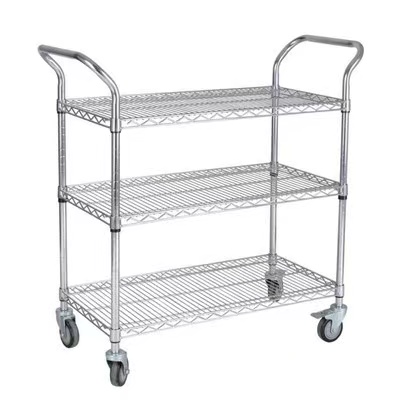FR1006 ESD Circulation cart
Products
Products DETAILS
FR1006 ESD Circulation cart
ESD Circulation Cart: A Complete Guide
An ESD Circulation Cart is a mobile, static-safe storage and transport solution designed for circulating electronic components, PCBs, tools, or trays in an ESD-protected environment. These carts ensure that electrostatic discharge (ESD) is safely dissipated, protecting sensitive electronic parts during movement within manufacturing, assembly, and testing facilities.
1. Key Features of an ESD Circulation Cart
a) ESD-Safe Materials
-
Constructed using conductive or static-dissipative materials, including:
-
Powder-coated steel or aluminum for durability and grounding.
-
ESD-safe plastic or laminated shelves for non-conductive storage.
-
Carbon-loaded or conductive polymer trays to prevent static buildup.
-
b) Multiple Storage Levels
-
Comes with two, three, or more tiers of shelves or trays for efficient organization.
-
Can include adjustable or removable shelves to accommodate various components.
-
Some models feature angled shelves to secure trays or bins in place.
c) Grounding System
-
Equipped with ESD-safe swivel caster wheels that dissipate static charge into the ground.
-
Some models include a grounding chain or wrist strap connection for extra protection.
d) Mobility and Stability
-
Heavy-duty caster wheels allow easy movement across production areas.
-
Locking wheels ensure stability when stationary.
-
Ergonomic push handles for effortless maneuverability.
e) Compliance with Industry Standards
-
Meets ANSI/ESD S20.20, IEC 61340-5-1, and ISO 14644 standards for ESD control and cleanroom use.
2. Where Are ESD Circulation Carts Used?
ESD circulation carts are commonly used in:
-
Electronics Manufacturing – For moving static-sensitive components between workstations.
-
PCB Assembly Lines – For circulating PCBs during assembly and inspection.
-
Cleanrooms & Laboratories – For contamination-free transport of electronic parts.
-
Semiconductor Facilities – To prevent electrostatic damage during chip handling.
-
Warehouses & Storage Areas – For organized ESD-safe material handling.
3. Choosing the Right ESD Circulation Cart
When selecting an ESD circulation cart, consider:
-
Material: Choose between powder-coated metal, aluminum, or ESD-safe plastic based on durability needs.
-
Number of Shelves: Decide on fixed or adjustable shelves to fit your components.
-
Storage Capacity: Ensure the cart can hold the required number of PCBs, trays, or tools.
-
Mobility: Select a cart with lockable ESD-safe casters for smooth and stable movement.
-
Compliance: Verify that the cart meets ANSI/ESD and IEC static control standards.





